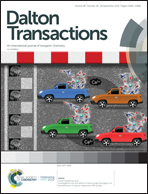Formation of a uranyl hydroxide hydrate via hydration of [(UO2F2)(H2O)]7·4H2O†
Abstract
Hydrated uranyl fluoride, [(UO2F2)(H2O)]7·4H2O, is not stable at elevated water vapor pressure, undergoing a complete loss of fluorine to form a uranyl hydroxide hydrate. Powder X-ray diffraction data of the resultant uranyl hydroxide species is presented for the first time, along with Raman and infrared (IR) spectra. The new uranyl hydroxide species is structurally similar to the layered uranyl hydroxide hydrate minerals schoepite and metaschoepite, but has a significantly expanded interlayer spacing (c = 15.12 vs. 14.73 Å), suggesting that additional H2O molecules may be present between the uranyl layers. Comparison of the Raman and IR spectra of this new uranyl hydroxide hydrate and synthetic metaschoepite ([(UO2)4O(OH)6]·5H2O) suggests that the equatorial environment of the uranyl ion may differ and that H2O molecules in the new species participate in stronger hydrogen bonds. In addition, the interlayer spacing of both this new uranyl hydroxide species and synthetic metaschoepite is shown to be sensitive to the environmental humidity, contracting and re-expanding with desiccation and rehydration. Structural distinction between the new uranyl hydroxide species and synthetic metaschoepite is confirmed by a comparison of the thermal behavior; unlike metaschoepite, the new hydrate does not form α-UO2(OH)2 upon dehydration.
![Graphical abstract: Formation of a uranyl hydroxide hydrate via hydration of [(UO2F2)(H2O)]7·4H2O](/en/Image/Get?imageInfo.ImageType=GA&imageInfo.ImageIdentifier.ManuscriptID=C9DT02835H&imageInfo.ImageIdentifier.Year=2019)


 Please wait while we load your content...
Please wait while we load your content...